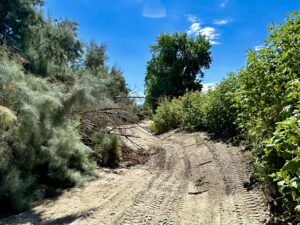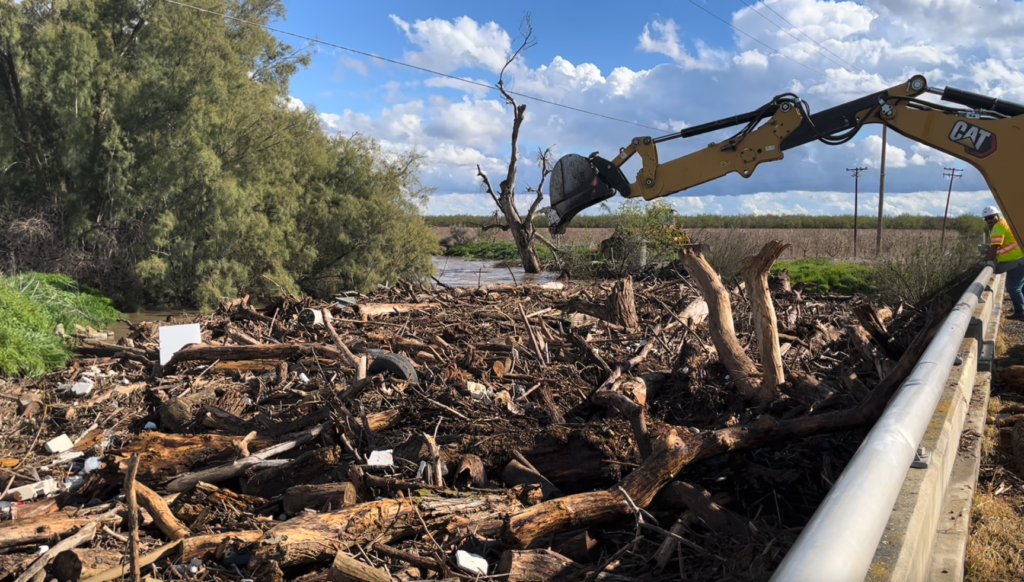Entire towns flooded last winter because of permit delays, according to lawmakers and others.
Debris from overgrown creeks and waterways up and down the state hadn’t been cleaned out in years for lack of proper permits. When water barreled down those channels, debris piled up, pushing water over levees and into hundreds of homes and businesses.
No one wants to see a repeat, but some are worried not enough is being done to make sure creeks and waterways are prepared for another potentially wet winter.
The California Department of Fish and Wildlife (CDFW), the main state-level permitting agency, agreed there were past delays, though it downplayed them as the culprit for last winter’s floods saying agencies could have gotten “emergency permits” if needed.
Others were leery of that, as CDFW may not define “emergency” the same as those agencies doing the work.
Either way, the fact is, channels had become wildly overgrown and strewn with years of garbage creating catastrophes on numerous waterways.
Merced flooding devastation
One of the worst instances in the San Joaquin Valley was in Merced County where authorities said permitting for several projects to clear out and repair Miles Creek was years behind.
Miles Creek busted its banks in January devastating the entire town of Planada. Residents are still trying to recover.
Staff from CDFW and the County of Merced would not elaborate on what caused the permitting delays.
CDFW required SJV Water to submit a Public Records Act Request to see the permitting agreement between those public agencies.
SJV Water filed the request on Oct. 27. So far, no records have been produced. The California Public Records Act states that records must be made available immediately upon request except under limited circumstances, such as documents regarding some personnel matters.
Channel maintenance on Miles Creek to improve flow during storms is performed by the Merced County Streams Group, which includes the county, the City of Merced and Merced Irrigation District. But the county is in charge of permitting efforts.
Some waterways, including Miles Creek, also require federal permits through the Army Corps of Engineers. But the delays this year on Miles Creek were with the CDFW, not the Army Corps.
Since the Planada flooding, the county has obtained a permit from CDFW, wrote Mike North, public information officer for Merced County, in an email. The county has also been operating under an executive order issued by Gov. Gavin Newsom in August that suspended some permitting requirements to perform repairs and maintenance, wrote North.
Miles Creek was hardly alone in the permit delay debacle.
Gummed up process
On the Kern River, the City of Bakersfield had been trying to renew its system-wide channel clearance permits, which it first began using in 1985, for several years.
Staffing “vacancies” at CDFW apparently held up the permit, which was actually approved in 2020 but never sent to the city. Bakersfield did use an emergency permit to clear a couple small sections of river bed within the city. But its permit with the Army Corps of Engineers was still pending months after the storms.
It had to position excavators along the river 24-7 to scoop out trees, shrubs and even some appliances. It ultimately hauled 90 tons of debris out of the river during the height of its runoff.
The Poso Creek in Kern County, similarly hadn’t been cleared out in years. Debris piled up in the Poso at the Highway 43 bridge and water gushed north, inundating the small town of Pond.

That channel is somewhat of a “no man’s land,” without any public agencies in charge along most of its pathway. Sometimes individual landowners or water districts have done work in the channel, but only to the boundaries of their own property.
The only flood prevention oversight on the creek exists at the end of its run where the Deer Creek Storm Water District has authority for the Poso’s last few miles before it dumps in the old Tulare Lake bed.
In response to the patchy, gummed up channel maintenance process, Newsom issued an executive order that suspended certain laws and regulations for repairs and debris removal, including doing away with the need to notify the CDFW of such projects, said Sarah Paulson, environmental program manager for the CDFW.
But that executive order ended on November 1. And it had no effect on the Army Corps’ permitting process.
“I actually took three calls this morning from landowners concerned that the executive order was running out,” said Paulson in an interview earlier in November.
Normally, CDFW oversees any modifications to streams and lakes. That includes any body of water that conveys water that isn’t man made. Landowners or agencies that want to do any alterations of a channel, such as vegetation or sediment removal, must notify the CDFW. The department then analyzes the project and has 30 days to respond to the notification. After that, the department has 60 days to issue a draft agreement. The applicant can then review the agreement and sign it, said Paulson. Most permits are good for five years, she added.
Still, delays can happen for many reasons, said Paulson.
Sometimes, the applicants don’t sign the agreements because they disagree with the terms and want changes, she said.
“They want changes that require some additional amount of analysis and coordination, a lot of times with other experts in the department and sometimes that can take a long time to work out,” said Paulson. “There can be a lot of factors.”
“Emergency,” in eye of beholder
But Paulson said there are still ways for projects to proceed smoothly in preparation for winter, pointing to emergency exemptions. Those allow people to do projects without prior notification or approval in emergency situations, said Paulson.
“It became apparent to the department early on in the winter season this year that we needed to make that really clear to folks,” said Paulson.
Emergency exemptions would certainly apply to projects for preparation before storms hit, she added. The emergency provision is still available to people who need to clean up damages from the last storms and prepare for any storms this year, she said.
Merced County staff said they were aware of the emergency provision.
“The County has used the CDFW emergency provisions when it is appropriate to do so,” wrote North. “There is no guarantee the CDFW will agree with the local entity that the scope of work meets their definition of an emergency.”
North continued that streamlining permitting processes is an effort that is still ongoing.
“We’re hopeful that it’s a smoother process in the future,” wrote North.
Share this:
- Click to share on Facebook (Opens in new window)
- Click to share on Twitter (Opens in new window)
- Click to share on LinkedIn (Opens in new window)
- Click to share on Reddit (Opens in new window)
- Click to share on Tumblr (Opens in new window)
- Click to share on Pinterest (Opens in new window)
- Click to share on Pocket (Opens in new window)
- Click to share on Telegram (Opens in new window)
- Click to share on WhatsApp (Opens in new window)
- Click to print (Opens in new window)









You must be logged in to post a comment.